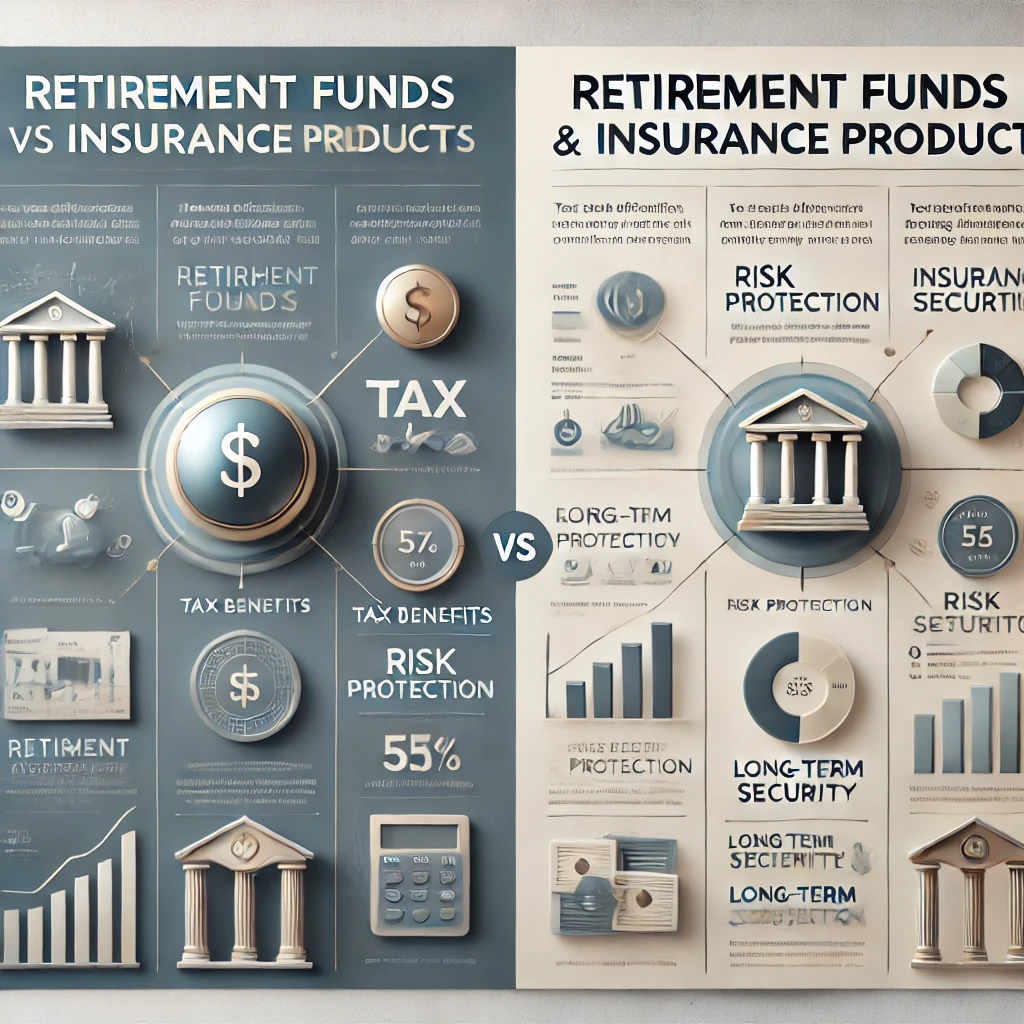Why Retirement Planning Should Combine Insurance and Pensions
In retirement planning, many people focus solely on 401(k), IRA, or pension plans, overlooking the crucial role insurance plays in securing retirement income and managing risk. According to the Investment Company Institute, as of 2024, the total retirement funds in the U.S. exceed $37 trillion, with 401(k) plans holding $7.5 trillion and IRA accounts holding $13.9 trillion. However, due to market fluctuations, inflation, and rising healthcare costs, relying solely on retirement funds may not provide sufficient financial security. This article explores Retirement Funds vs Insurance, comparing their benefits and risks to help you build the optimal retirement plan for long-term stability.
In recent years, an increasing number of people have adopted a “Pension + Insurance” strategy to ensure steady cash flow and greater flexibility when dealing with healthcare expenses and estate planning. This article delves into how to balance retirement accounts (such as 401(k), IRA, pensions) with insurance products (like annuities, life insurance, and long-term care insurance) to create a more comprehensive retirement plan.
1. Core Pension Options
In the U.S., the main sources of retirement income typically include 401(k), IRA, and pension plans, each offering distinct advantages and catering to different demographics.
1.1 401(k) Plans
- Employer Matching Contributions: Many employers offer matching contributions, which is essentially “free money.”
- Tax Advantages: Traditional 401(k) allows pre-tax contributions, while Roth 401(k) allows post-tax contributions and tax-free withdrawals in retirement.
- Investment Growth: Funds in the account can be invested in stocks, bonds, mutual funds, etc.
1.2 Individual Retirement Accounts (IRA)
- Traditional IRA: Pre-tax contributions with taxable withdrawals in retirement.
- Roth IRA: Post-tax contributions with tax-free withdrawals in retirement.
- SEP IRA / SIMPLE IRA: For self-employed individuals or small business owners.
1.3 Pension Plans
- Government and Corporate Pensions (Defined Benefit Plans): Provide a fixed income for life but are becoming less common.
- Private Pensions (Annuities): Include annuities and other private retirement income tools.
2. How Does Insurance Play a Role in Retirement Planning?

Insurance not only helps mitigate unexpected risks but also plays a vital role in stabilizing income, reducing tax burdens, and covering healthcare expenses during retirement. The following three types of insurance are especially important in retirement planning:
2.1 Annuities
- What is an Annuity? An annuity is an income tool that guarantees a stream of payments, either for life or for a set period.
- Fixed Annuities: Provide stable, guaranteed returns.
- Variable Annuities: Tied to market performance, potentially offering higher returns but carrying market risk.
- Indexed Annuities: Tied to a stock market index with a guaranteed minimum return.
2.2 Long-Term Care Insurance (LTCI)
- Why is LTCI important in retirement? According to the U.S. Department of Health and Human Services (HHS), 70% of Americans over the age of 65 will need some form of long-term care during their lifetime, and the costs can be exorbitant:
- Home Care: Around $60,000 per year.
- Nursing Homes: Around $100,000 per year.
Long-term care insurance helps cover these high medical expenses, preventing your retirement savings from being quickly depleted.
2.3 Life Insurance
- Term Life Insurance: Provides coverage for a set period (e.g., 20 or 30 years), usually at a lower cost.
- Whole Life Insurance: Offers both death benefits and cash value accumulation, which can be used for loans or supplementing retirement income.
3. How to Balance Insurance and Pensions in Retirement Planning
Retirement planning is not just about saving money but also about balancing “long-term growth” (pensions) with “risk management” (insurance). Over-reliance on pension accounts can lead to reduced funds due to market volatility, while depending entirely on insurance might cause you to miss out on potential investment returns. So, how do you find the best balance?
3.1 Pension vs. Insurance: A Comparison of Core Functions
| Item | Retirement Accounts (401(k)/IRA, etc.) | Insurance (Annuities, Life Insurance, LTCI) |
|---|---|---|
| Main Purpose | Asset growth, wealth accumulation | Securing funds, managing risks |
| Investment Returns | High (6-8% annually in long-term stock investments) | Lower (3-5% annually for fixed annuities) |
| Tax Advantages | Traditional IRA/401(k) offer pre-tax deductions, Roth IRA is tax-free | Cash value life insurance grows tax-deferred, some withdrawals tax-free |
| Liquidity | Withdrawals before age 59.5 are subject to taxes and a 10% penalty | Life insurance cash value can be borrowed, no early withdrawal penalties |
| Risk | Subject to market volatility (risk of losing principal in bear markets) | Fixed returns, avoids market risk |
| Inheritance | Beneficiaries must withdraw within 10 years | Life insurance can be passed on tax-free |
Conclusion: Pensions are for growth, while insurance is for protection. Combining both ensures a more stable financial future for retirement.
3.2 How to Balance Insurance and Pensions? Three Strategies
Strategy 1: 80% Pension + 20% Insurance (For high-risk tolerance individuals)
- Main Assets: Focus most funds in 401(k), IRA, etc., to maximize long-term investment growth.
- Insurance Role: Only purchase basic term life insurance, without adding annuities or cash value life insurance.
- Target Audience: Under 40 years old, high-risk tolerance, willing to embrace market fluctuations.
Strategy 2: 60% Pension + 40% Insurance (For moderate retirement planners)
- Main Assets: Maintain most funds in 401(k) or IRA but add annuities for steady cash flow.
- Insurance Role: Buy whole life insurance, which can be used as a tax-free source of withdrawals.
- Target Audience: 40-55 years old, seeking growth but also stability.
Strategy 3: 40% Pension + 60% Insurance (For risk-averse individuals)
- Main Assets: Invest more in annuities to secure fixed retirement income unaffected by market fluctuations.
- Insurance Role: Use indexed annuities and cash value life insurance for growth and tax advantages.
- Target Audience: 55+ years old, nearing retirement or already retired, looking to reduce market risk.
Key Point: The younger you are, the more you can invest in pension accounts. The older you get, the more insurance you need to ensure stability in your retirement funds.
3.3 Case Study: Optimizing Retirement Plans
Case 1: 30-Year-Old Tech Employee – Focus on Pension Accounts, Minimize Insurance Costs
- Background: 30 years old, single, earning $120,000 annually, employer offers a 401(k) match.
- Strategy:
- Pension: Max out 401(k) contributions ($23,000/year) and invest in Roth IRA ($7,000/year).
- Insurance: Purchase 20-year term life insurance, no annuities.
- Reason: Young, with ample time to accumulate growth-oriented assets, rather than locking in fixed returns.
Conclusion: How Will You Distribute Your Retirement Plan?
If you’re younger (30-40 years old), focus more on investing in 401(k)/IRA, with less emphasis on insurance. If you’re in your 50s-60s, you should consider increasing your insurance and fixed-income products to ensure stability in retirement.
4. Actual Cases: Successful Retirement Planning Strategies
Case 1: 401(k) + Annuity
📌 Background: Mike, 55 years old, plans to retire in 10 years and wants to ensure stable income after retirement.
✅ Strategy:
• Continue contributing to 401(k) and invest in index funds.
• At 60, convert part of the 401(k) funds into a fixed annuity to ensure lifetime income.
Case 2: Roth IRA + Life Insurance
📌 Background: Lisa, 42 years old, wants to reduce future tax burdens and leave wealth for her children.
✅ Strategy:
• Open a Roth IRA and maximize contributions.
• Purchase whole life insurance to ensure that her children can inherit funds and utilize the cash value to supplement retirement income.
Case 3: Traditional IRA + Long-Term Care Insurance
📌 Background: Steve, 50 years old, is concerned that future medical expenses may impact his retirement lifestyle.
✅ Strategy:
• Continue contributing to a Traditional IRA and delay withdrawals for tax-deferred growth.
• Purchase long-term care insurance to cover potential medical expenses.
5. New Trends in Retirement Planning for 2025
In 2025, retirement planning faces new challenges and opportunities, including adjustments to social security benefits, innovations in insurance products, and market uncertainties. Understanding these trends can help optimize your retirement plan.
🔹 5.1 Changes in Social Security Benefits: Potential Adjustments in 2025
The U.S. Social Security Administration (SSA) may adjust the Social Security benefits policy in 2025, affecting retirees’ benefit amounts and withdrawal methods. Possible changes include:
✅ Eligibility Age Adjustments: Currently, Social Security can be claimed as early as age 62, but in 2025, the full retirement age (FRA) may increase to encourage people to delay retirement.
✅ Benefit Amount Adjustments: If inflation continues to rise, the annual cost-of-living adjustment (COLA) for Social Security may increase, meaning retirees could receive more benefits.
✅ Tax Changes: If the federal government increases taxes on high-income individuals, it may affect the after-tax income from Social Security.
📌 Strategy:
• If your retirement income relies heavily on Social Security, it’s recommended to closely follow government policy and adjust your retirement budget accordingly.
• Consider delaying Social Security benefits (e.g., claiming at age 70) to receive higher monthly payments.
🔹 5.2 Innovations in Insurance Products: Rise of Hybrid Annuities and Life Insurance
The insurance market is introducing more flexible products to help retirees manage their funds, such as:
✅ Hybrid Annuities: Combining fixed annuities and indexed annuities, these products offer guaranteed returns with market growth potential.
✅ Life Insurance with LTC Benefits: These products not only provide death benefits but also allow withdrawals for long-term care needs.
✅ Tax-Free Income Strategies: Using Roth IRAs and cash value life insurance (e.g., Whole Life Insurance) to create tax-free retirement income.
📌 Strategy:
• If you’re looking for stable retirement income with some growth potential, consider hybrid annuities.
• If you’re concerned about medical and long-term care costs, consider life insurance with LTC benefits instead of purchasing standalone LTC insurance.
🔹 5.3 Market Volatility Response Strategies: How to Protect Retirement Assets in an Uncertain Economy?
In 2025, economic markets may continue to face high inflation, interest rate fluctuations, and stock market instability. The following strategies can help reduce risk:
✅ Diversification:
• Appropriately allocate assets in stocks, bonds, real estate, and gold to reduce the risk of a market collapse.
• Ensure you have at least 3-5 years of cash flow for retirement to weather market downturns.
✅ Withdrawal Strategy Adjustments:
• Adopt a dynamic withdrawal strategy: Withdraw more when the market is good and reduce withdrawals when the market is poor to protect your principal.
• Combine the “bucket strategy,” dividing retirement funds into short-term (cash flow), medium-term (stable income), and long-term (growth) segments to handle different market conditions.
📌 Strategy:
• Consider putting some funds into fixed-income investments (e.g., annuities) to ensure stable cash flow in retirement.
• If the market is down, minimize withdrawals from 401(k) and IRA accounts to avoid selling assets at a low point.
6. Conclusion: How to Create a Personalized Retirement Plan?
No matter what your retirement goals are, you need a long-term and flexible plan. Key steps include:
📌 1. Assess Financial Goals
• Calculate your expected retirement age and monthly retirement income needs.
• Understand your Social Security benefits, 401(k), IRA, and other income sources.
📌 2. Choose the Right Tools
• If you seek long-term stable growth, consider index funds and annuities.
• If you’re concerned about medical and long-term care costs, consider long-term care insurance or life insurance with LTC benefits.
📌 3. Regularly Adjust Your Plan
• Market fluctuations, tax policies, and Social Security changes may affect your retirement income. It’s recommended to reassess your financial situation every year.
• As you age, gradually adjust your investment portfolio by reducing high-risk assets and increasing stable income products (e.g., bonds, annuities).
7. Frequently Asked Questions (FAQ)
Q1: Pension vs. Insurance, which is more important?
✅ Pension (401(k), IRA): This is the core source of retirement funds for most people, providing long-term investment growth and tax advantages.
✅ Insurance (Annuities, Life Insurance, Long-Term Care Insurance): Primarily used to mitigate risks and provide additional protection, ensuring you won’t face financial hardship in retirement.
📌 Best Approach: Use both—e.g., invest in 401(k) for long-term growth while using annuities to ensure stable income.
Q2: If funds are limited, should I invest in retirement accounts or buy insurance first?
✅ If you have employer-matched 401(k) contributions, prioritize contributing at least the matching amount, as this is “free money.”
✅ If you already have some retirement savings but are concerned about medical or long-term care costs, consider purchasing long-term care insurance (LTCI) or life insurance with LTC benefits.
📌 Priority Recommendations:
1️⃣ Start with 401(k) or IRA to maximize tax advantages.
2️⃣ Then supplement with insurance to protect retirement assets from medical costs.
Q3: How can I maximize the combination of Social Security and private pensions?
✅ Delay Social Security: For each year you delay, Social Security benefits increase by 8% until age 70.
✅ Use Roth IRA for tax optimization: Withdraw from Roth IRA first (tax-free), then take from 401(k) or Social Security to reduce overall tax burden.
✅ Purchase annuities to supplement retirement cash flow and reduce the market risk of early withdrawals from 401(k).
📌 Example Strategy:
• 62-69 years: Withdraw tax-free income from Roth IRA.
• 70 years and above: Start claiming Social Security and use 401(k) for additional funds.
💬 Have you started planning your retirement yet?
🔹 How do you balance retirement accounts and insurance?
🔹 What do you think will be the biggest challenge for retirement planning in 2025?
Feel free to share your thoughts in the comments! If you found this article helpful, please like, share, and recommend it to others!
Authoritative Sources for Retirement Funds vs Insurance:
1. Retirement Funds (401(k), IRA, Pension Plans)
✅ Investment Company Institute (ICI) – Latest U.S. retirement account statistics
✅ U.S. Department of Labor – 401(k) Plans – Regulations and guidelines for 401(k) plans
✅ Internal Revenue Service (IRS) – IRA Rules – Official IRA contribution and withdrawal rules
2. Insurance for Retirement (Annuities, Life Insurance, Long-Term Care)
✅ National Association of Insurance Commissioners (NAIC) – Insurance market data and consumer guides
✅ American Council of Life Insurers (ACLI) – Information on life insurance and annuity products
✅ U.S. Department of Health & Human Services – Long-Term Care Insurance – Federal resources on long-term care coverage
3. Social Security & Comprehensive Retirement Planning
✅ Social Security Administration (SSA) – Benefits – Social Security claiming strategies and calculators
✅ Fidelity – Retirement Planning Strategies – Investment strategies and income planning for retirees
✅ AARP – Retirement Planning Advice – Financial advice and tools for retirees







